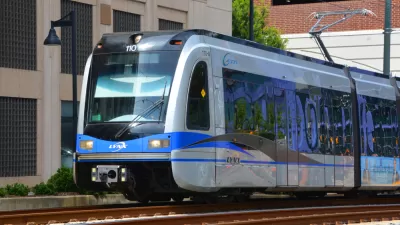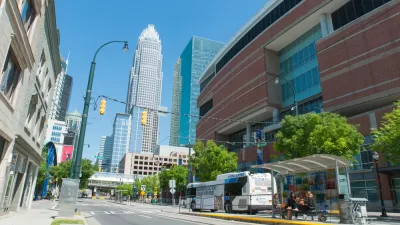One of the arguments against sprawl and its variety of manifestations is the large amount of public subsidies, for private benefit, required to make it work. North Carolina will consider a small step in ending the free ride.
"North Carolina drivers pay one of the nation’s highest gasoline taxes to take care of roads and bridges – and their tax money also takes care of developers, utilities, outdoor advertisers and other business people who pay little or nothing for services that cost the state Department of Transportation millions of dollars each year," begins an article by Bruce Siceloff and Eric Frazier. It's a common story around the country, but North Carolina is considering a way to break from the status quo.
Short $5 billion for the goals of the Charlotte Area Transit System’s long-range 2030 plan, North Carolina Department of Transportation "officials are recommending new fees that would scale back this taxpayer subsidy and shift the burden to businesses."
"The most expensive areas for no-fee services are related to subdivision development and encroachments on state highway rights of way…preliminary figures suggest that taxpayers may be covering $2 million to $5 million in department costs." Those are only two of the services that will be targeted for new fees, according to Siceloff and Frazier. The article lists nine possible fees in total. One troubling possibility for the open data movement: a proposed fee for crash reports of the variety requested by traffic court lawyers and others "that analyze the crash histories of state roads free of charge."

Alabama: Trump Terminates Settlements for Black Communities Harmed By Raw Sewage
Trump deemed the landmark civil rights agreement “illegal DEI and environmental justice policy.”

Study: Maui’s Plan to Convert Vacation Rentals to Long-Term Housing Could Cause Nearly $1 Billion Economic Loss
The plan would reduce visitor accommodation by 25% resulting in 1,900 jobs lost.

Planetizen Federal Action Tracker
A weekly monitor of how Trump’s orders and actions are impacting planners and planning in America.

Waymo Gets Permission to Map SF’s Market Street
If allowed to operate on the traffic-restricted street, Waymo’s autonomous taxis would have a leg up over ride-hailing competitors — and counter the city’s efforts to grow bike and pedestrian on the thoroughfare.

Parklet Symposium Highlights the Success of Shared Spaces
Parklets got a boost during the Covid-19 pandemic, when the concept was translated to outdoor dining programs that offered restaurants a lifeline during the shutdown.

Federal Homelessness Agency Places Entire Staff on Leave
The U.S. Interagency Council on Homelessness is the only federal agency dedicated to preventing and ending homelessness.
Urban Design for Planners 1: Software Tools
This six-course series explores essential urban design concepts using open source software and equips planners with the tools they need to participate fully in the urban design process.
Planning for Universal Design
Learn the tools for implementing Universal Design in planning regulations.
Caltrans
Smith Gee Studio
Institute for Housing and Urban Development Studies (IHS)
City of Grandview
Harvard GSD Executive Education
Toledo-Lucas County Plan Commissions
Salt Lake City
NYU Wagner Graduate School of Public Service





























